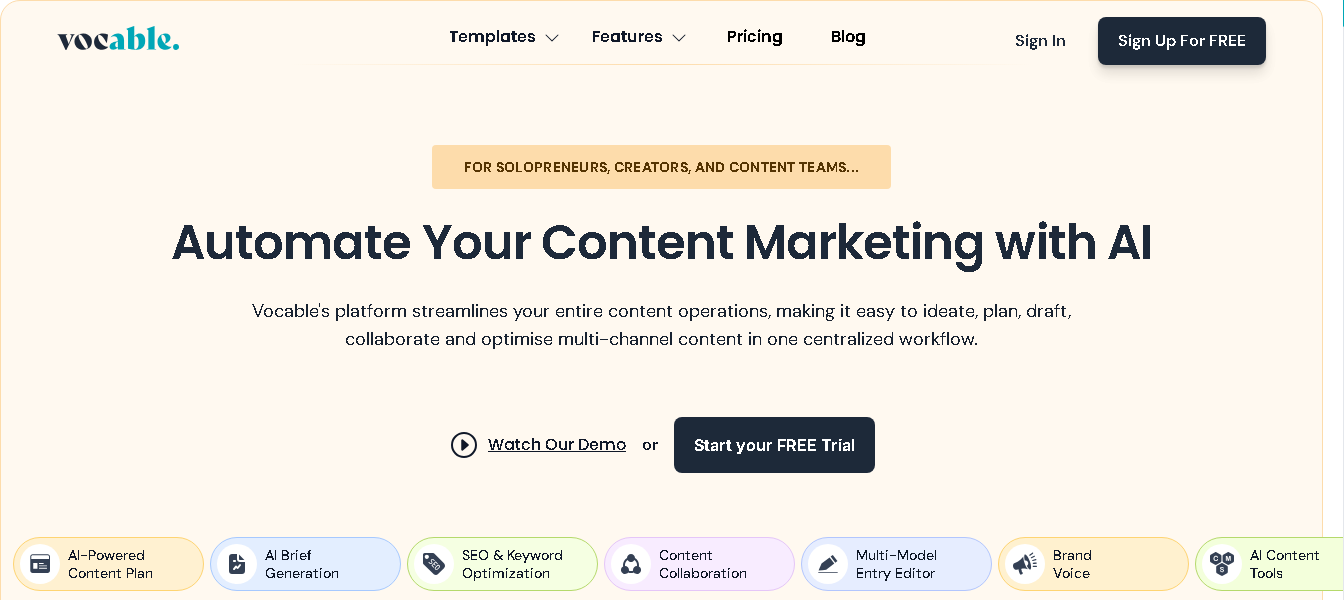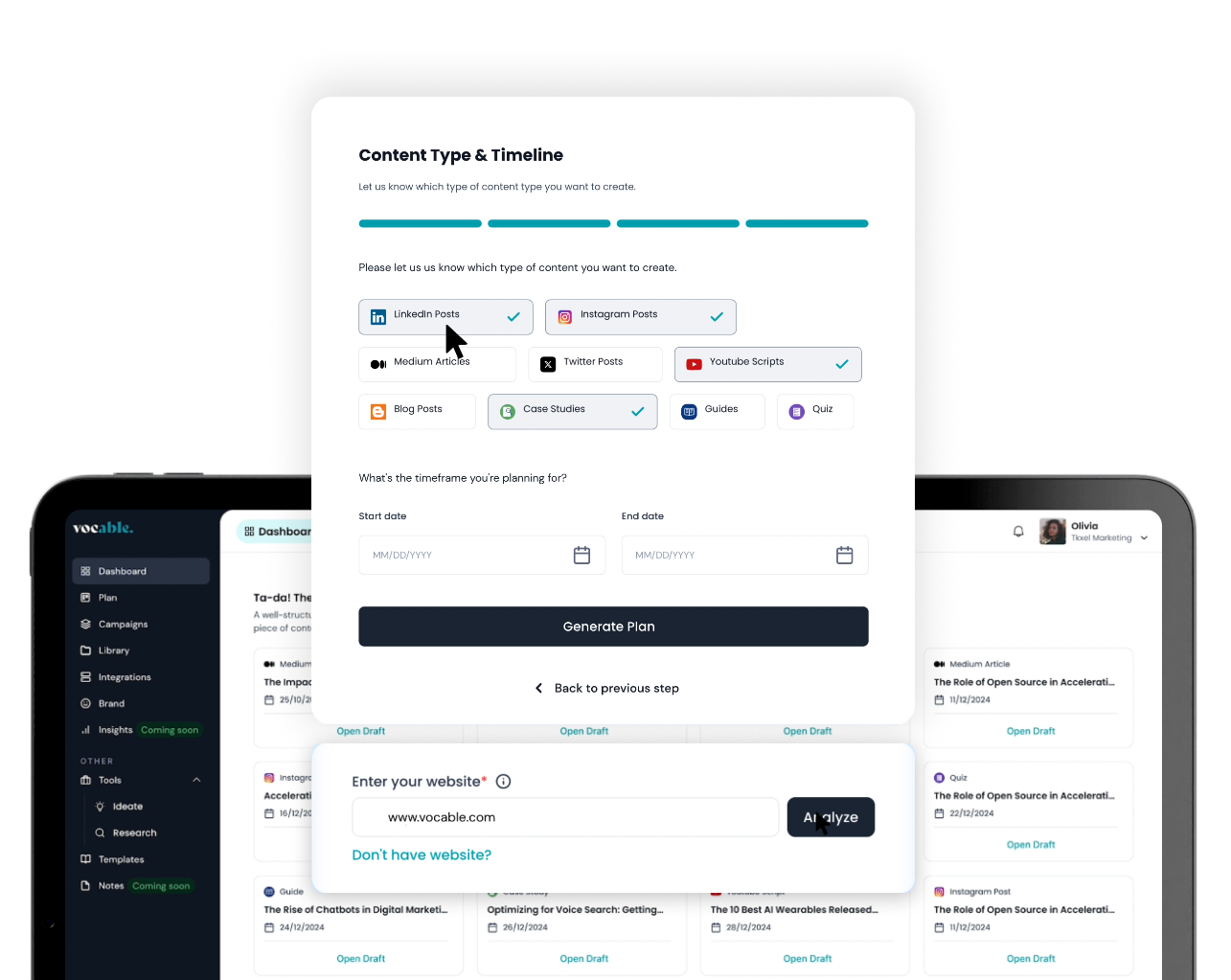Why Most AI-Generated Content Flops (And How to Fix It)

Iman OubouFebruary 20, 2025 4 min read
Let me share a story that’s happening in marketing teams and content agencies everywhere. Imagine this: a content manager, excited about their shiny new AI writing tool, cranks out dozens of articles in no time.
The grammar? Flawless. The structure? Perfect. Yet somehow, these pieces land with all the impact of a feather hitting a pillow.
Here’s the thing. We’re in this exciting moment where AI promises to change content creation in big ways. But there’s a bit of irony: the very tools meant to make our content better sometimes make it feel less human.
The Uncomfortable Truth About AI Content
I’ve seen it countless times. Business owners and marketers, armed with the latest AI tools, churn out content that checks all the technical boxes but misses that ineffable quality that makes readers lean in and think, “This person gets it.” The problem isn’t the AI—it’s how we’re using it.
To explain it in detail, let’s look at specific cases where AI can go sideways.
Tone and Voice Problems
Think about the last time you read an AI-generated article that felt… off. You might not have noticed it right away, but something about it felt cold and distant—like talking to someone reading straight from a script.
That’s what happens when we use AI as a replacement instead of a partner in the creative process.
Lack of Originality and Creativity
One of the biggest issues with AI-generated content? It’s just not that creative. AI can analyze patterns and spit out something that looks like a human would write, but it doesn’t come up with fresh ideas or unique takes.
It’s like talking to someone who just repeats the same thing in different ways. After a while, it all sounds the same.
It’s All About Quantity, Not Quality
AI makes it so easy to crank out content that it’s tempting to just keep going. Blog post after blog post, social media caption after caption. But more isn’t always better. You need to ask: Does this content really say something useful? Or are we just filling space? Quality always wins.
And there’s another thing with Google as well. Many believe Google punishes AI-generated content, but that’s not true. Google Search Central confirms it rewards high-quality content, no matter how it’s created.
However, since AI pulls from pre-existing data, there’s a higher risk of plagiarism or repeating information that doesn’t add value, hence lowering the quality of your content. This can affect your content’s overall performance in Google search results.
Factual Errors and Made-Up Info
AI isn’t exactly the most reliable fact-checker. Sometimes, it just makes things up. I know that sounds wild, but it’s true. AI doesn’t actually “know” facts. It’s trained to predict text based on patterns, not verify the accuracy of what it’s writing.
SEO Headaches
If you’re using AI to boost SEO, be careful. AI content doesn’t always play nice with search engines. Sometimes, it gets keyword-happy and stuffs too many into the text. Other times, it totally misses what search engines look for—content that actually helps people.
Legal and Ethical Headaches
Here’s something not everyone thinks about: Who actually owns AI-generated content? This can get murky. AI pulls from a lot of different sources when it’s generating text, which means there’s always a chance it might copy something without realizing it.
That opens the door to plagiarism and copyright issues.
The Science Behind the Struggle
Here’s what’s really interesting about AI-generated content: the very things that are supposed to make it “perfect” are the same things that often make it fall flat.
You know what I mean—that super-polished grammar, perfectly structured sentences, and textbook-level flow. On paper, it should be great. But in reality, it just feels… off.
AI content often tries too hard to be perfect. It’s clean, but sometimes too clean. And that’s where it struggles. Real writing connects with people because it feels human. It’s a little messy. It’s not always perfectly balanced. But that’s what makes it interesting and real.
How to Fix AI-Generated Content: A Strategic Framework
Let me tell you what I’ve learned from working with AI content tools and seeing both the big wins and total flops. The secret isn’t in the fancy tech or writing the perfect prompt—it’s all about working with AI and using a smart strategy.
Here’s how to turn average content into something truly valuable:
1. Rethinking Your AI Partnership
Instead of treating your AI tool like a content vending machine, think of it as your slightly quirky research assistant. Here’s how I approach it:
First, I feed it context like I’m catching up with a colleague who’s been out of the loop. “Hey, here’s what’s happening in our industry, here’s what our audience is worried about, and here’s the unique angle we want to explore.”
Then comes the fun part—taking that AI-generated draft and making it authentically yours. Add those industry war stories that only you know. Throw in that slightly controversial opinion you’ve been mulling over. Share that failed experiment that taught you more than any success.
2. Enhance Your Prompting Strategy
It all starts with giving AI the right guidance. Don’t just type in a simple prompt—treat it like a creative brief.
Include these key elements in your prompts:
- Know your audience: Include details like their interests, struggles, and needs.
- Use industry-specific language: Add terms and phrases that match your field.
- Provide examples: Share successful content with the tone and style you want to match.
- Incorporate data and case studies: Give AI relevant facts to build on.
- Set clear goals: What do you want the content to achieve? Be specific about the outcomes.
When you give this kind of detail, you’ll get AI-generated content that’s more on-point and polished.
3. Implement a Three-Phase Review System
AI can generate content quickly, but it still needs a solid review process. Here’s a simple three-phase system to improve quality:
Phase 1: Technical Assessment
Start by making sure the content is accurate and well-structured.
- Fact-check all data: Don’t assume numbers and facts are correct. Double-check them.
- Check for logical flow: Ensure the argument makes sense from start to finish.
- Remove AI-generated filler: Look for vague or generic statements and cut them out.
- Use proper terminology: Make sure technical terms are correct and used in context.
Phase 2: Human Enhancement
Now, add the human touch to make the content more insightful and relatable.
- Add industry insights: Include real-world examples and experiences.
- Use unique research or proprietary data: This will make your content more valuable.
- Include personal stories: Share anecdotes that connect with your audience.
- Develop creative metaphors: These can help explain complex ideas in a simple way.
When working on adding a human touch to AI content, I run it through what I call the “coffee shop test”:
- Would this sound natural if I were explaining it to a friend over coffee?
- Does it include insights that could only come from real experience?
- Does it make the reader feel something, or is it just informing?
If it fails any of these, it needs further humanizing.
Phase 3: Reader Experience Optimization
Finally, focus on how the content feels for the reader.
- Test readability: Ask for feedback from your target audience.
- Optimize for search intent: Make the content easy to find with SEO best practices.
- Add visuals and interactive elements: Charts, videos, and infographics help keep readers engaged.
- Prioritize mobile-friendly formatting: Make sure the content looks great on any device.
3. Develop Content Hybridization Techniques
The best content blends AI’s speed with human creativity and expertise. Here’s how to do it:
- Keep human oversight: Always review for tone, brand voice, and emotional impact.
- Let AI handle the basics: Use AI for research, summarizing, and drafting the first version.
- Add strategic insights: Use your expertise to bring depth and a unique point of view.
- Use AI for scaling: AI tools can help optimize and repurpose your content for multiple channels.
4. Address Legal and Ethical Concerns
AI-generated content isn’t always straightforward. Legal and ethical risks can come up if you’re not careful. Here’s what to watch out for and how to stay safe:
Things to be careful about:
- Plagiarism risks: AI tools sometimes copy existing text without realizing it.
- Copyright concerns: Publishing unchecked AI content could land you in legal trouble.
- Transparency questions: Should your audience know the content was AI-generated? Many expect honesty.
When to Rely on AI vs. Human Creativity
AI can save you time and make things easier, but some of the tasks you do still need a human touch. Let’s break it down into when AI is your best bet and when human creativity makes all the difference.
Tasks Where AI Works Best
AI shines when it comes to handling straightforward, formulaic tasks. If it’s something repetitive or purely functional, AI can save you loads of time without sacrificing too much quality.
Content Idea Generation
One of the most time-consuming parts of writing is coming up with fresh content ideas. AI tools can analyze trends, keywords, and existing content to suggest new topics. This makes brainstorming sessions faster and more productive.
Repurposing Content
AI tools are great at repackaging existing content into new formats. For instance, you can turn a long blog post into short social media captions, email content, or even a summary for a newsletter.
Social Media Captions and Hashtag Suggestions
Writing multiple social media captions can feel tedious. AI can generate variations of captions in different tones (formal, casual, or playful), helping you create engaging content quickly. Many tools can even suggest relevant hashtags based on your post content.
Data-Driven Content
If your writing requires analyzing or summarizing large datasets, AI is your best friend. It can quickly process complex information and turn it into a simplified explanation or even a visual representation like a chart.
Email Personalization and Automation
AI can help you create personalized email content at scale, which would take forever to do manually. Whether you’re writing sales follow-ups, newsletters, or customer support replies, AI can generate relevant, customized responses based on user data.
Creating Frequently Asked Questions (FAQs)
AI can analyze your site’s content and customer queries to generate FAQ sections. This saves you time while ensuring that your site provides quick answers to common questions.
Content Translation
If you want to reach a global audience, AI-powered translation tools can help translate content into multiple languages. While it’s still important to have a human review, AI gets you 80% of the way there.
Real-Time Content Updates
AI can help you update old content by suggesting new data, statistics, or more recent examples. This keeps your content fresh and relevant without rewriting it from scratch.
When Human Creativity Wins
AI is pretty powerful, but there are times when nothing beats human creativity. Let’s talk about when human creativity should always take the lead.
Brand Storytelling
Your brand’s story isn’t something AI can understand or replicate. It’s about personal experiences, lessons learned, and what makes your journey unique.
Storytelling is powerful because it creates an emotional connection with your audience. AI might provide a rough draft or suggest ideas, but only you can tell your brand’s story in a way that resonates with readers.
Emotional Writing
AI doesn’t have feelings. It can write about emotions, but it can’t feel them. That means it misses the little nuances that make writing relatable and heartfelt.
Whether you’re writing a blog post about personal growth or a piece on overcoming failure, human writers can tap into emotions in a way AI simply can’t.
Opinion Pieces and Thought Leadership
If you’re writing an opinion piece or trying to establish yourself as a thought leader in your industry, your personal experience and perspective are everything.
AI can generate facts and summarize trends, but it can’t form opinions or make predictions. Readers look for unique insights, not just information they’ve seen before.
Complex Topics Requiring Context and Nuance
Certain topics are just too complex for AI to handle well. These might include sensitive subjects (like mental health or social issues) or highly technical writing that requires deep expertise. AI struggles to provide the context and nuance that make these topics accurate and thoughtful.
Creative Campaigns and Marketing Copy
AI can write product descriptions and summaries, but when it comes to truly creative work—like developing a catchy ad campaign or writing witty social media content—you’ll want to rely on human creativity.
These tasks require a mix of humor, wordplay, and cultural awareness that AI simply doesn’t have.
Content That Requires Strong Visual Storytelling
Visual content—especially when combined with powerful writing—requires a human touch. Whether you’re writing a script for a video, a storyboard for a campaign, or a photo essay, you need creative direction that only a human can provide.
Writing for Different Cultures and Contexts
Cultural sensitivity and context are essential when writing for diverse audiences. AI doesn’t have the life experience or understanding to adjust language and tone for different cultural backgrounds, which can lead to awkward or even offensive content.
Human writers can tailor their approach to fit the audience’s needs, ensuring the message feels relevant and respectful.
Avoid Common AI Content Mistakes—Start With Vocable

Vocable is a complete AI content management platform built to help you create high-quality, relevant content at scale. While AI content saves time, it often misses the mark on brand consistency, SEO, and that human touch.
Vocable fixes this with structured workflows, real-time collaboration, and built-in optimization tools, making sure every piece of content supports your business goals.
Here’s how Vocable helps you overcome the challenges of AI-generated content:
Maintain Brand Voice and Consistency
AI content can sometimes feel generic or off-brand. Vocable solves this with autogenerated content briefs that include your brand tone, target audience, and SEO keywords. This keeps your content aligned with your unique brand identity from the start—no more adjusting drafts to fit your voice.
Create SEO-Optimized Content From Day One
AI-generated content often misses key SEO elements. Vocable’s built-in Keyword Research Tool ensures your content is optimized for search engines without extra effort. Industry-specific keywords are baked into every draft, helping your content rank higher without manual tweaks.
Reduce Errors and Ensure Content Accuracy
AI tools can sometimes generate factually incorrect information. With Vocable’s collaborative editing and review workflow, your team can easily review content, add feedback, and track changes—all within one platform. This reduces the risk of errors and helps deliver accurate, reliable content.
Improve Collaboration and Workflow
AI-generated content doesn’t always fit neatly into existing workflows. Vocable’s structured content workflow guides your team through each step—from ideation to approval. Real-time collaboration makes it easy for remote teams to work together and avoid miscommunication.
Make Data-Driven Decisions With Vocable Analytics
Vocable’s AI-powered analytics provide insights into content performance, audience engagement, and user behavior. This data helps your team refine content strategies and focus on what works, ensuring you stay on track and avoid creating irrelevant content.
Avoid Over-Reliance on Automation
Automation is great, but human input is still essential for quality content. Vocable’s multi-model entry editor lets your team combine the strengths of multiple AI models with human expertise. This balance leads to more polished, nuanced, and creative content.
Take Control of AI Content With Vocable
Don’t let common AI content challenges hold your team back. With Vocable, you’ll avoid the usual pitfalls and produce high-quality, on-brand content every time.
Get started with Vocable and turn AI content into your competitive advantage!
FAQs About the Pitfalls of AI-Generated Content
What are the disadvantages of AI-generated content?
AI-generated content has some downsides that are hard to ignore. It often lacks originality and a human touch.
Since it’s based on patterns in existing data, it can sometimes feel repetitive or generic. Artificial intelligence can also miss the mark when trying to capture emotions, humor, or cultural context.
Another issue is the risk of inaccuracies because AI can create content that sounds right but isn’t factually correct. For content creation processes that need creativity or complex thinking, a human writer is still a better option.
Is AI-generated content bad for SEO?
AI-generated content isn’t necessarily bad for search engine optimization, but it can hurt your SEO if you’re not careful.
Low-quality or irrelevant content can lower rankings and drive readers away. When creating AI-generated content, it’s important to focus on high-quality content that uses relevant keywords naturally.
These are just a few examples. Overall, generative AI tools can speed up the process, but they still require human input to make the content useful and engaging. Combining AI tools with a human touch helps create content that performs better in search results.
What is one major ethical concern in the use of generative AI?
One big ethical concern with generative AI is the potential for spreading misinformation. Since natural language processing tools rely on existing data, they can inherit errors or biases from that data. If the data isn’t carefully checked, the AI might generate misleading or false information.
There’s also the question of fairness when AI-generated content competes with human writing. Over-reliance on AI could reduce opportunities for human writers, which raises issues about jobs and originality in content creation.
Why do 85% of AI projects fail?
AI projects fail mainly due to poor planning, unrealistic expectations, and bad data. Many businesses lack a clear strategy and underestimate how much high-quality data AI tools need.
Misalignment between technical teams and business goals also causes failure. Without a solid plan, reliable data, and a clear purpose, AI projects often fall short.
Which are AI pitfalls to avoid?
One common pitfall in creating AI-generated content is treating it like a fully automatic solution. While AI tools help speed up the content creation process, they need supervision to avoid producing inaccurate or irrelevant content.
Another trap is forgetting to personalize or add a human element. Readers connect better with authentic, relatable writing.
Relying too heavily on AI-generated text without editing can result in dull content that doesn’t engage your audience or meet SEO goals. Keep an eye on quality, accuracy, and tone to avoid these cons of AI-generated content.
Get Started with Vocable
Master every aspect of Vocable, from automated content planning to publishing in these step-by-step tutorials and product guides.
Get Started Now





